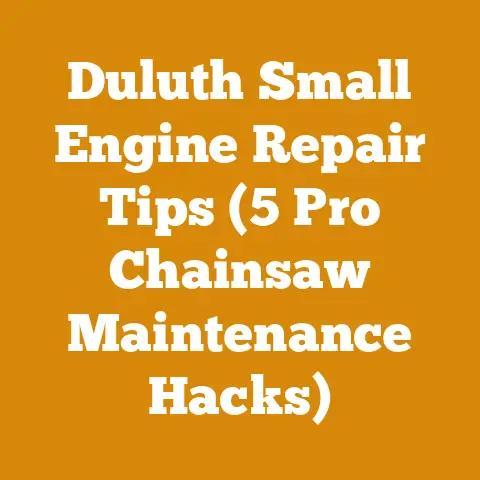Husqvarna 372xp Bar Tips (5 Expert Hacks for Optimal Cutting)
I’ve seen it countless times. Someone buys a powerful chainsaw like the Husqvarna 372xp, ready to tackle some serious wood, but they neglect one of the most crucial aspects: taking care of the bar. It’s like buying a high-performance sports car and never changing the oil. You’re setting yourself up for disappointment, and potentially, a dangerous situation. Ignoring proper bar maintenance isn’t just about reducing efficiency; it’s about increasing the risk of kickback, premature wear, and ultimately, costing you more money in the long run.
Husqvarna 372xp Bar Tips: 5 Expert Hacks for Optimal Cutting
The Husqvarna 372xp is a beast of a machine. I’ve used it for felling large trees, bucking firewood, and even some light milling. But its performance hinges heavily on the condition of its bar. These tips aren’t just suggestions; they’re lessons I’ve learned the hard way over years of working with chainsaws.
Hack 1: Regular Bar Cleaning: The Foundation of Longevity
Imagine running your chainsaw bar through sawdust, pitch, and grime all day, every day. That’s precisely what happens if you don’t clean it regularly. This buildup not only hinders performance but also accelerates wear on the bar and chain.
Why Cleaning Matters:
- Reduces Friction: Debris creates friction between the chain and the bar, requiring more power and generating more heat.
- Prevents Corrosion: Sap and moisture can corrode the bar, leading to rust and weakening its structure.
- Ensures Proper Oiling: A clean bar allows oil to flow freely, lubricating the chain and reducing wear.
My Experience:
I once neglected cleaning my bar after felling a particularly sappy pine tree. The next day, the chain was running sluggishly, and the bar felt hot to the touch. I had to spend a good hour cleaning it with a wire brush and solvent to restore its performance. I learned my lesson then!
How to Clean Your Bar:
- Remove the Bar and Chain: Always disconnect the spark plug for safety. Loosen the bar nuts and remove the chain and bar.
- Use a Wire Brush: A stiff wire brush is your best friend. Scrub away any accumulated sawdust, pitch, and grime from the bar rails, sprocket nose (if applicable), and oil holes.
- Solvent Cleaning: For stubborn pitch or sap, use a solvent like kerosene or a citrus-based cleaner. Apply the solvent to a rag and wipe down the bar. Avoid soaking the bar in solvent for extended periods.
- Clean the Oil Holes: Use a small wire or a specialized bar groove cleaner to clear any blockages in the oil holes. Proper oil flow is crucial for lubrication.
- Clean the Bar Groove: Use a bar groove cleaner or a flattened piece of metal to remove debris from the bar groove. This ensures the chain sits properly and runs smoothly.
- Dry Thoroughly: Before reassembling, make sure the bar is completely dry to prevent rust.
Tool List:
- Wire brush
- Kerosene or citrus-based cleaner
- Rags
- Small wire or bar groove cleaner
- Gloves
Frequency:
I recommend cleaning your bar after every 8 hours of use, or more frequently if you’re cutting particularly sappy or dirty wood.
Takeaway: Regular bar cleaning is a simple yet crucial step in maintaining your Husqvarna 372xp’s performance and extending the life of your bar and chain. Make it a habit, and you’ll thank yourself later.
Hack 2: Bar Rail Dressing: Maintaining Optimal Chain Contact
The bar rails are the surfaces that guide the chain around the bar. Over time, they can become worn, uneven, or burred, leading to poor chain tracking, increased vibration, and premature chain wear. Dressing the bar rails restores their shape and ensures optimal chain contact.
Why Bar Rail Dressing Matters:
- Improves Chain Tracking: Even bar rails ensure the chain runs straight and true, reducing vibration and improving cutting efficiency.
- Reduces Chain Wear: Proper chain contact minimizes friction and wear on the chain.
- Prevents Chain Jumping: Worn or uneven bar rails can cause the chain to jump off the bar, which can be dangerous.
My Experience:
I once had a bar that was causing excessive vibration and chain jumping. I initially thought it was a chain issue, but after closer inspection, I noticed the bar rails were severely worn and uneven. After dressing the rails with a bar rail dresser, the vibration disappeared, and the chain ran smoothly.
How to Dress Your Bar Rails:
- Inspect the Bar Rails: Carefully examine the bar rails for any signs of wear, burrs, or unevenness. Use a file or a straight edge to check for flatness.
- Use a Bar Rail Dresser: A bar rail dresser is a specialized tool designed for precisely dressing bar rails. It consists of a handle and a file or grinding stone.
- Dress the Rails Evenly: Hold the bar rail dresser at a consistent angle and gently file or grind the bar rails, removing any burrs or unevenness. Work in smooth, even strokes, ensuring you remove the same amount of material from each rail.
- Check for Squareness: After dressing the rails, use a file or a straight edge to check that they are square and even.
- Deburr the Edges: Use a fine file or sandpaper to deburr the edges of the bar rails, removing any sharp edges that could damage the chain.
Tool List:
- Bar rail dresser
- File or straight edge
- Fine file or sandpaper
- Gloves
Frequency:
I recommend dressing your bar rails every 25 hours of use, or more frequently if you notice any signs of wear or unevenness.
Takeaway: Bar rail dressing is a relatively simple procedure that can significantly improve your chainsaw’s performance and extend the life of your bar and chain. Invest in a good bar rail dresser and make it a part of your regular maintenance routine.
Hack 3: Bar Rotation: Even Out the Wear
Chainsaw bars tend to wear unevenly because one side is typically used more than the other. Rotating the bar periodically helps to distribute wear more evenly, extending its lifespan.
Why Bar Rotation Matters:
- Evens Out Wear: Rotating the bar ensures that both sides wear at a similar rate, preventing premature failure.
- Maximizes Bar Life: By distributing wear evenly, you can significantly extend the life of your bar.
- Improves Cutting Performance: A more evenly worn bar will provide better chain tracking and cutting performance.
My Experience:
I used to replace my chainsaw bars every year or so. Then, I started rotating them every time I sharpened my chain. To my surprise, my bars started lasting twice as long! It’s a simple habit that makes a big difference.
How to Rotate Your Bar:
- Remove the Bar and Chain: Always disconnect the spark plug for safety. Loosen the bar nuts and remove the chain and bar.
- Flip the Bar: Simply flip the bar over so that the top side is now facing down.
- Reinstall the Bar and Chain: Reinstall the bar and chain, ensuring that the chain is facing the correct direction.
- Adjust Chain Tension: Adjust the chain tension to the proper specification.
Tool List:
- Wrench for loosening bar nuts
- Gloves
Frequency:
I recommend rotating your bar every time you sharpen your chain, which is typically every 2-3 tanks of fuel.
Takeaway: Bar rotation is the easiest maintenance task you can perform. It takes only a few minutes, but it can significantly extend the life of your bar. Make it a habit, and your wallet will thank you.
Hack 4: Proper Chain Tension: The Key to Efficient Cutting
Maintaining proper chain tension is crucial for efficient cutting, preventing chain damage, and ensuring operator safety. Too loose, and the chain can jump off the bar. Too tight, and it can overheat and break.
Why Proper Chain Tension Matters:
- Efficient Cutting: Properly tensioned chain cuts smoothly and efficiently.
- Prevents Chain Damage: Correct tension reduces wear and tear on the chain, extending its life.
- Ensures Operator Safety: A properly tensioned chain is less likely to jump off the bar, reducing the risk of kickback and other accidents.
My Experience:
I recall a time when I was cutting firewood with a chain that was too loose. The chain kept jumping off the bar, which was frustrating and time-consuming. After tightening the chain to the proper tension, the cutting became much smoother and more efficient.
How to Adjust Chain Tension:
- Loosen the Bar Nuts: Loosen the bar nuts slightly, but don’t remove them completely. This will allow you to adjust the bar position.
- Adjust the Tensioning Screw: Locate the chain tensioning screw on the side of the chainsaw. Turn the screw clockwise to tighten the chain and counterclockwise to loosen it.
- Check the Tension: The chain should be snug against the bar, but you should still be able to pull it around the bar by hand. A good rule of thumb is that you should be able to pull the chain out from the bar about 1/8 inch (3mm) at the midpoint of the bar.
- Tighten the Bar Nuts: Once you have achieved the proper tension, tighten the bar nuts securely.
- Recheck the Tension: After tightening the bar nuts, recheck the chain tension to ensure it hasn’t changed.
Tool List:
- Wrench for loosening bar nuts
- Screwdriver or wrench for adjusting the tensioning screw
- Gloves
Frequency:
Check chain tension before each use and adjust as needed. The chain will stretch as it heats up, so you may need to readjust it during use.
Takeaway: Proper chain tension is essential for safe and efficient cutting. Take the time to check and adjust the chain tension before each use, and you’ll avoid a lot of frustration and potential problems.
Hack 5: Oil, Oil, Oil: Never Skimp on Lubrication
Proper lubrication is the lifeblood of your chainsaw bar and chain. Without adequate oil, the chain will overheat, wear prematurely, and eventually break. The bar will also suffer from increased friction and wear.
Why Proper Lubrication Matters:
- Reduces Friction: Oil lubricates the chain and bar, reducing friction and heat.
- Extends Chain Life: Proper lubrication minimizes wear and tear on the chain, extending its lifespan.
- Extends Bar Life: Adequate oil reduces friction between the chain and the bar, preventing premature wear.
- Improves Cutting Performance: A well-lubricated chain cuts smoothly and efficiently.
My Experience:
I once ran my chainsaw without checking the oil level. After only a few minutes of cutting, the chain started smoking and became incredibly dull. I had to replace the chain and thoroughly clean the bar. Now, I always make sure the oil reservoir is full before each use.
How to Ensure Proper Lubrication:
- Use the Right Oil: Use a high-quality bar and chain oil specifically designed for chainsaws. Avoid using motor oil or other substitutes, as they may not provide adequate lubrication. I prefer a synthetic blend for its superior performance in varying temperatures.
- Check the Oil Level Regularly: Check the oil level in the reservoir before each use and refill as needed.
- Adjust the Oiler: Most chainsaws have an adjustable oiler that allows you to control the amount of oil delivered to the bar and chain. Adjust the oiler to provide adequate lubrication without excessive oil consumption. I usually set mine to a point where I see a light spray of oil coming off the chain while cutting.
- Clean the Oiler: Periodically clean the oiler to ensure it’s functioning properly. Debris can clog the oiler and restrict oil flow.
- Check for Oil Flow: While the chainsaw is running, check to see if oil is being delivered to the bar and chain. You should see a light spray of oil coming off the chain.
Tool List:
- Bar and chain oil
- Funnel for filling the oil reservoir
- Screwdriver for adjusting the oiler
Frequency:
Check the oil level before each use and refill as needed. Clean the oiler periodically, especially if you’re cutting dirty or sappy wood.
Takeaway: Never skimp on lubrication. Using the right oil, checking the oil level regularly, and adjusting the oiler properly are essential for maintaining your chainsaw’s performance and extending the life of your bar and chain.
Bonus Tip: Storing Your Chainsaw Properly
How you store your Husqvarna 372xp also impacts the bar’s lifespan.
Why Proper Storage Matters:
- Prevents Rust and Corrosion: Storing your chainsaw in a dry place prevents rust and corrosion on the bar and chain.
- Protects Against Damage: Proper storage protects the bar and chain from physical damage.
- Maintains Sharpness: Storing the chain properly helps to maintain its sharpness.
How to Store Your Chainsaw Properly:
- Clean the Chainsaw: Before storing your chainsaw, clean it thoroughly, removing any sawdust, pitch, or grime.
- Drain the Fuel: Drain the fuel tank to prevent fuel from going stale and clogging the carburetor.
- Remove the Bar and Chain: Remove the bar and chain and clean them thoroughly.
- Store the Bar and Chain Separately: Store the bar and chain separately in a dry place. Consider using a bar cover to protect the bar from damage. I like to wrap my chain in an oily rag to prevent rust.
- Store the Chainsaw in a Dry Place: Store the chainsaw in a dry place, away from moisture and direct sunlight.
- Consider a Chainsaw Case: A chainsaw case provides added protection against damage and keeps all your chainsaw accessories organized.
Tool List:
- Bar cover
- Chainsaw case (optional)
- Oily rag
Frequency:
Follow these storage procedures whenever you’re not using your chainsaw for an extended period.
Takeaway: Proper storage is the final piece of the puzzle. By following these simple storage tips, you can protect your investment and ensure that your Husqvarna 372xp is ready to perform when you need it.
These five hacks, combined with consistent attention to detail, will significantly extend the life of your Husqvarna 372xp bar and chain. Remember, a well-maintained chainsaw is a safer, more efficient, and more enjoyable tool to use. Happy cutting!






